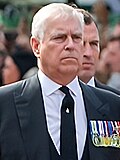This article contains historical images which have been upscaled using AI .(December 2024) |
This article needs additional citations for verification .(May 2019) |
| Earldom of Inverness | |
|---|---|
| Creation date | 23 June 1986 |
| Creation | Fourth |
| Created by | Elizabeth II |
| Peerage | Peerage of the United Kingdom |
| First holder | Prince Augustus Frederick |
| Present holder | Andrew Mountbatten-Windsor (not using title) |
| Remainder to | the 1st Earl's heirs male of the body lawfully begotten |
| Status | Extant, not in use [1] |
The title of Earl of Inverness (Scottish Gaelic: Iarla Inbhir Nis) is a title of nobility in the Peerage of the United Kingdom. It was first created in 1718 in the Jacobite Peerage of Scotland, together with the titles Viscount of Innerpaphrie and Lord Cromlix and Erne, by James Francis Edward Stuart ("James III & VIII") for the Honourable John Hay of Cromlix, third son of the 7th Earl of Kinnoull. He was created Duke of Inverness in 1727, but both titles became extinct upon the death of the grantee in 1740.
Contents
- Earls of Inverness, first Creation (1801)
- Earls of Inverness, second Creation (1892)
- Earls of Inverness, third Creation (1920)
- Earls of Inverness, fourth Creation (1986)
- Family tree
- References
It has been created several times in of the Peerage of the United Kingdom, each time as a subsidiary title for a member of the royal family. It was created first in 1801 as a subsidiary title of Prince Augustus Frederick, Duke of Sussex, sixth son of George III, becoming extinct in 1843. Sussex's second wife, Cecilia Underwood (whom he married in contravention of the Royal Marriages Act 1772 making the marriage legally void), was given the title of Duchess of Inverness in her own right, which became extinct upon her death in 1873.
The next creation was for Prince George (later George V), second son of Albert Edward, Prince of Wales (later Edward VII) and grandson of Queen Victoria, as a subsidiary title along with the Dukedom of York. As the Prince became King in 1910, succeeding his father, his titles merged in the crown.
The title was created again in 1920 as a subsidiary title of the Prince Albert (second son of George V), who was also created Duke of York at the same time. The title merged in the crown when Albert succeeded his brother in 1936 to become King George VI.
The title was created a fourth time in 1986 as a subsidiary title for Queen Elizabeth II's second son, Prince Andrew, along with the title of Baron Killyleagh. [2]
In 2019, some residents of Inverness started a campaign to strip him of that title, stating that "it is inappropriate that Prince Andrew is associated with our beautiful city," in reference to the prince's infamous friendship with disgraced financier and child sex trafficker Jeffrey Epstein. [3] In 2022, there was a renewed petition to remove his title. [4] On 17 October 2025, Andrew announced he would cease to use all his honours and titles. [5]



